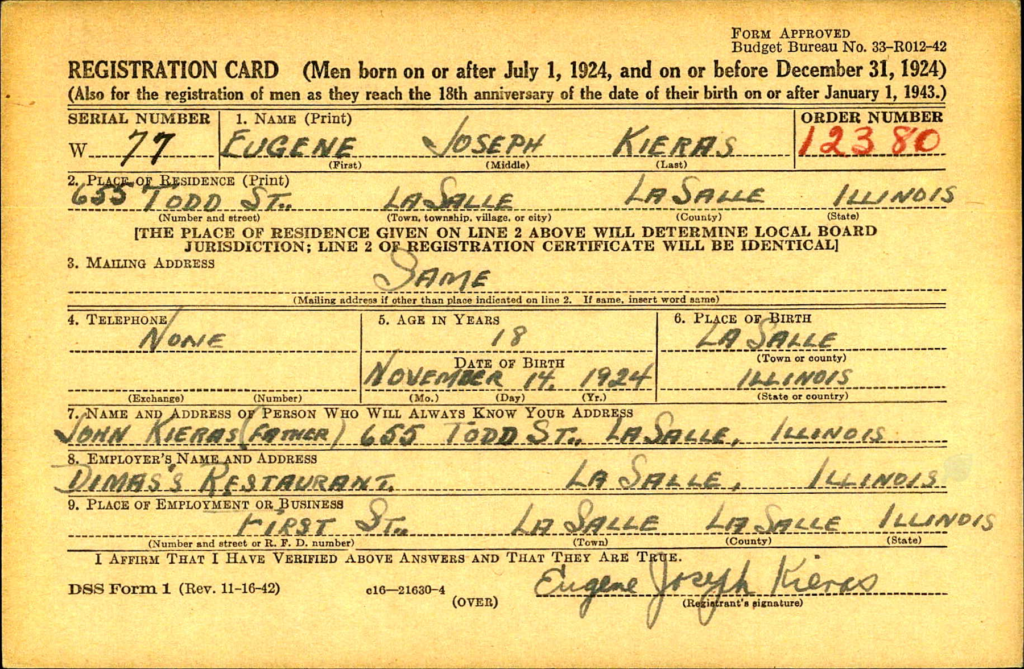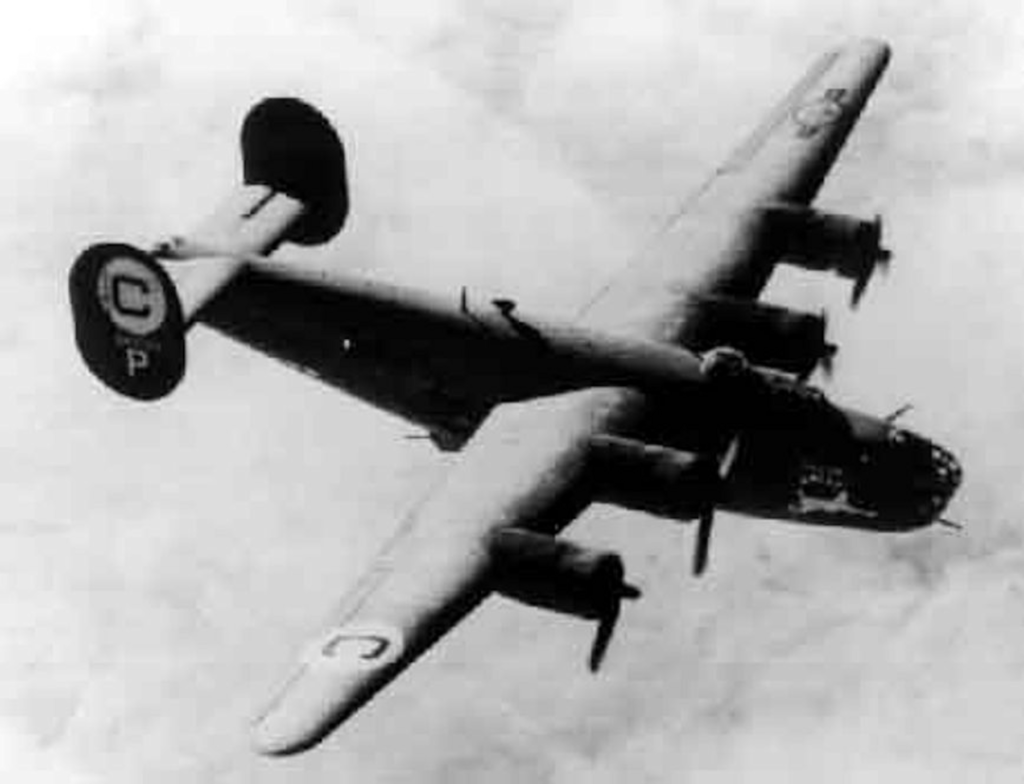Eugene “Gene” Joseph Kieras was born on 14 November 1924, in LaSalle, Illinois. He was the third child of John and Mary Theresa (Brzygot) Kieras. Their two older children were sons Stanley and Edward. Gene’s parents were both born in the area and married in LaSalle four years before his birth on 20 April 1920. After Gene, John and Mary Kieras had two more sons: Ernest and Raymond.
Around the time Gene was born his family was living at 1220 Eight street in LaSalle, but they moved several times throughout his childhood. Their longest stay during his life was in a home at the rear of 1249 Eleventh street. Gene’s father had a steady job at the local zinc factory making a decent wage, reported to be $1200 a year in 1940.
Gene and his siblings most likely would have known and spent time with his grandparents, all of whom immigrated from Poland in the late 1880s. Like Gene’s father, both of his grandfathers, Anthony Kieras and George Brzygot, worked at a local zinc factory. When Gene was 13 years old, his grandfather Anton Kieras passed away on 23 June 1938, in Peru, Illinois. The next year, his maternal grandmother—Bertha Piecha Brzygot—passed away.
While Gene did not appear to have any aunts or uncles on his maternal side, his father had been one of at least 14 children although 6 did not make it to adulthood. Gene’s two youngest uncles—Michael and Stanley Kieras—were twins who were five when Gene was born. However, Michael was one of the six who died in childhood passing away at age nine after a month-long illness.
In the late 1930s Gene entered LaSalle-Peru Township High School. But perhaps with the threat of war, he decided to leave school after his sophomore year. He may also have been following the lead of his older brother Stanley who left school after his freshman year and entered the work force. By the end of 1942 when Gene registered for the draft on 29 December 1942, he was working as a waiter at Dimas’s Restaurant in LaSalle. He was 18 years old at the time and stood 6 feet tall weighing 165 pounds with brown hair and eyes.

Not long after registering, Gene enlisted in the U.S. Army Air Corps on 9 April 1943, in Peoria, Illinois. The Kieras brothers would all end up serving in the military with at least four of them doing so during the war. Gene’s older brother Edward enlisted in 1940 in the U.S. Army Air Corps before the U.S. entered the conflict. Their brother Stanley enlisted in the U.S. Navy on 21 April 1944. Gene’s younger brother Ernest served during the war as a Torpedoman’s Mate in the U.S. Navy on the USS Charles F. Hughes (DD428). Their youngest brother Raymond served in the U.S. Navy, but it is unclear if he did so during the war as he turned 18 about 5 months before the war ended.
Military service for the Kieras family was nothing new; Gene’s father John had served for about two years in the U.S. Army during World War I. John’s brother Frank, Gene’s uncle, had also served in World War I for two years in Company G of the 129th Infantry.
In June 1943, Gene was sent to train at the Aviation Mechanics School at Keeler Field in Mississippi. There he was promoted to Private First Class. After graduating from the school on 31 October 1943, he attended the Flexible Gunnery School at Tyndall Field in Panama City, Florida. He completed the course and was awarded his wings and promoted to corporal in January 1944. After taking a furlough, Gene was assigned to a crew with the 579th Bomb Squadron in the 392nd Bomb Group, Heavy. They trained at Pueblo, Colorado, and then at Topeka, Kansas. Before leaving the states, Gene was allowed a 3-day pass to visit with his family. By June 1944, he and his crew were stationed at Wendling Air Base in England. Between 3 August 1944, and 11 September 1944, Gene participated in 14 bombing missions. After the eighth mission, he was promoted to Staff Sergeant. Then after the last mission, he was promoted to Technical Sergeant.

On 18 September 1944, T/SGT Kieras and nine other crew members took off on a B-24 Liberator named “Feathered Injun” as part of Operation Market Garden. Their mission was to deliver supplies to an area near Arnheim. Therefore, they had a new crew member PVT Edward Yensho whose primary duty was to oversee dropping of the cargo, each of which had its own parachute. There was also another new crew member on board. S/SGT Elton Southwell joined them as a replacement for T/SGT Morton Baker who had taken sick with abdominal pain and was in the hospital.
The aircraft they flew was also new to the crew and had been converted to hold cargo and drop supplies rather than bombs. The aircraft’s name was originally “No Feathered Injun” with a depiction of a cartoon character of a Native American with no feather. But a prior crew painted on a feather and crossed out the “No” to reflect more of a play on words which referenced the action of feathering to improve engine control.
On this flight, T/SGT Eugene Kieras was the flight engineer for the mission while another man from his hometown, 2nd LT David Grandon, was serving as navigator. 1st LT James Gerow was their pilot. 1st LT Gerow said PVT Edward Yensho flew with the mission as drop master and was stationed in the waist. As 1st LT Gerow later described that day: PVT Yensho “directed the dropping of our bundles over the target and then was free of any specific duties. Part of the bundles were released through the hole (where the Sperry Ball is normally installed) in the floor and the rest in the bombays. I had lost one engine (#2) over the target area and most of the gas from the second cell but was managing to keep up with the formation.” On the way back, T/SGT Eugene Kieras “called saying rudder cables were gone (which I knew) and to turn on automated pilot. My automatic pilot was out of order. Shortly afterwards my no. 3 engine started going out and I decided to gain what altitude I could before #3 was gone and to head for Brussels, rather than start out over the water and face almost certain ditching. It was after we were headed for Brussels that I called all members of the crew and told them to be prepared for an immediate bail out if I deemed it necessary. Each reported they would comply and that none were wounded seriously enough to hinder this procedure.
Approximately 10 minutes from Brussels we were hit again, and the ship was set on fire in the bombays. Just before this last bit I had sent my engineer [T/SGT Kieras] to the waist to repair rudder cables. When hit, the fire spread rapidly in the bombays and I called the crew over the interphone to Bail Out and pressed the warning bell. We were at 1700 feet indicated but the ship seemed to be losing altitude. I trimmed up the plane as best I could and felt the crew had had sufficient time to bail out so bailed out myself. Those in the waist had two methods for escape (the hole in the floor and the hatch) and since PVT Yensho was wearing a back-type parachute pack and was uninjured (as far as other members had ascertained). I do not understand why he did not leave.”
However, being in the front of the plane, 1st LT Gerow did not realize that T/SGT Kieras who was in the waist could not get to his parachute because of the fire. Instead, he thought perhaps Kieras jumped with a damaged parachute. But S/SGT Brink told others that because T/SGT Kieras could not get to his parachute due to the fire, he tried to attempt a tandem jump with S/SGT Brink. But when S/SGT Brink’s parachute opened, T/SGT Kieras was knocked off falling to his death in a meadow of what was locally known as the “Molenhof farm.”
Initially the Germans occupying the area prevented local residents from going near the body of T/SGT Kieras. The German soldiers searched his body then left it lying in the meadow. After the Germans left, the local doctor, Kees Griep, examined his body. The doctor along with the local headmaster Piet van den Dries and others then took T/SGT Kieras and prepared his body for burial. They did the same for PVT Yendro who had been found in the wreckage of the plane. A ceremony was held for both at the town hall of Heinkenszand. On 21 September 1944, the people of the town held a funeral ceremony during which both young men were buried in the local cemetery.
The other eight crew members also landed in Holland yet survived the jump. S/SGT Loyce Ely, who was a good friend of T/SGT Kieras, and 2nd LT Joseph Sulkowski avoided capture. Both were assisted by the residents of the area in which they landed. Those who helped them took great risks to hide the two airmen for weeks in a small room in a rectory in ‘s-Heer Abtskerke until a Canadian force routed the Germans. After the area was freed from occupation, S/SGT Ely and 2nd LT Sulkowski came out of hiding and were able to return to Wendling. Meanwhile the six remaining crew members including 2nd LT Grandon were taken prisoner by the Germans and sent to prison camps. They were eventually freed when Germany surrendered in 1945.
A memorial mass was held in June 1945 for T/SGT Eugene Kieras in his hometown at St. Hyacinth’s Catholic Church. He was the 17th parishioner of the church who had lost their life serving in the war. After the war, the body of T/SGT Eugene Kieras was removed and buried in a permanent gravesite at Ardennes American Cemetery and Memorial in Belgium. Awards he received include the Air Medal with Oak Leaf Cluster, American Campaign Medal, WW2 Victory Medal, European-African-Middle Eastern Campaign Medal, and the Army Good conduct Medal. He did not receive a Purple Heart because his death was considered a parachute accident. Gene’s older brother Edward served throughout all of World War II and remained in the military until retiring from service as a Master Sergeant on 30 June 1960. 2nd LT Grandon—Eugene’s crew member who was also from LaSalle—was released from the German Prison Camp Stalag Luft 1 near Barth, Germany, in May 1945.
Members of the 42-94866 Crew:
- Pilot 1 LT James A. Gerow, O-817422, POW Returned
- Co-Pilot 2 LT Frederick J. Vallarelli, O-820858, POW Returned
- Navigator 2 LT David P. Grandon, O-716421, POW Returned
- Bombardier 2 LT Joseph T. Sulkowski, O-717116, Returned
- Radio Operator S SGT Elton E. Southwell, 17077744, POW Returned
- Top Turret T/SGT Eugene J. Kieras, 36480578, KIA
- Waist Gunner S/SGT Benjamin E. Brink, 6066148, POW Returned
- Waist Gunner S/SGT Loyce E. Ely, 39685203, Returned
- Air Trans Tech (Drop Master) PVT Edward Yensho, 35928650, KIA
- Tail Gunner S/SGT Normand B. Hebert, 6905947, POW Returned
Note, throughout this story, James Gerow is referred to as 1st LT which is the title he gained while held as a prisoner of war.
A photo of the crew can be found here: https://www.b24.net/aircrew/Gerow-crew-AStockwell.jpg
An individual photo of T/SGT Eugene J. Kieras can be found here: https://www.b24.net/aircrew/Kieras-Eugene-J-JGilbert.jpg. Credit for the photo posted on Together We Served and Fold 3: www.b24.net
More details about T/SGT Eugene Kieras, his crew, and those who helped Gene and his crew members can be found in the book Holland Drop Zone written by Mark van den Dries—a grandson of Piet van den Dries.

This story is part of the Stories Behind the Stars project (see www.storiesbehindthestars.org). This is a national effort of volunteers to write the stories of all 421,000+ of the US WWII fallen saved on Together We Served and Fold3. Can you help write these stories? These stories will be accessible via smartphone app at any war memorial or cemetery.
If you noticed anything erroneous in this profile or have additional information to contribute to it, please email feedback@storiesbehindthestars.org.
- SBTSProject/Illinois/LaSalle
- SBTS Historian Pam Broviak
You can also access this story at the following sites:
Source List:
- 1900 U.S. Census, Wojc Brgygot, Ancestry.
- 1900 U.S. Census, Anthony Keras, Ancestry.
- 1910 U.S. Census, Anthony Kiras, Ancestry.
- 1930 U.S. Census, John Kieras, Ancestry.
- 1940 U.S. Census, John, Kieras, Ancestry.
- U.S., City Directories, 1822-1995, LaSalle, 1924, John Kieras, p. 151, Ancestry.
- U.S., City Directories, 1822-1995, LaSalle, 1926, John Kieras, p. 129, Ancestry.
- U.S., City Directories, 1822-1995, LaSalle, 1928, John Kieras, p. 165, Ancestry.
- U.S., City Directories, 1822-1995, LaSalle, 1932, John Kieras, p. 129, Ancestry.
- U.S., City Directories, 1822-1995, LaSalle, 1935, John Kieras, p. 127, Ancestry.
- U.S., City Directories, 1822-1995, LaSalle, 1937, John Kieras, p. 129, Ancestry.
- https://www.findagrave.com/memorial/60995774/michael-kieras.
- https://www.findagrave.com/memorial/69601398/bertha-brzygot
- Illinois, U.S., Deaths and Stillbirths Index, 1916-1947, Anton Kieras, Sr., Ancestry.
- U.S., Social Security Death Index, 1935-2014, Stanley J. Kieras, Ancestry.
- U.S., School Yearbooks, 1900-1999, LaSalle-Peru Township High School, 1939, p. 9, Ancestry.
- https://www.findagrave.com/memorial/80078526/stanley-l.-kieras
- https://www.findagrave.com/memorial/169070287/raymond-f.-kieras
- https://www.findagrave.com/memorial/64222313/ernest-kieras
- U.S., World War II Navy Muster Rolls, 1938-1949, Ernest Anthony Kieras, USS Charles F. Hughes, 1945, Ancestry.
- U.S., World War II Draft Cards Young Men, 1940-1947, Eugene Joseph Kieras, Ancestry.
- U.S., World War II Army Enlistment Records, 1938-1946, Eugene J. Kieras, Ancestry.
- U.S., Department of Veterans Affairs BIRLS Death File, 1850-2010, Stanley Kieras, Ancestry.
- U.S., Department of Veterans Affairs BIRLS Death File, 1850-2010, John Kieras, Ancestry.
- U.S., Department of Veterans Affairs BIRLS Death File, 1850-2010, Frank Kieras, Ancestry.
- “United States, Veterans Administration Master Index, 1917-1940,” Frank Kieras, FamilySearch.
- “Edward J. Kieras,” San Angelo Standard Times, p. 2, col 3–5, Newspapers.com.
- Monument Location B-24H Liberator 42-94886 Feathered Injun, Traces of War website.
- Missing Air Cre Reports, 42-94886, Fold3.
- “Lt. David P. Grandon is Released from Air Corps Prison Camp in Germany,” Sterling Daily Gazette, 21 May 1945, p. 3, NewspaperArchive.com.
- 392nd Bomb Group website (for mission lists and two photos of Eugene Kieras).
- U.S., Headstone and Interment Records for U.S., Military Cemeteries on Foreign Soil, 1942-1949, Eugene J. Kieras, Ancestry.
- Mark van den Dries and Robert A. Hebert (translator). 2021. Holland drop zone: the crash of an American bomber in a Dutch polder. Soesterberg: Uitgeverij Aspekt.
- https://www.findagrave.com/memorial/56359139/eugene-j.-kieras